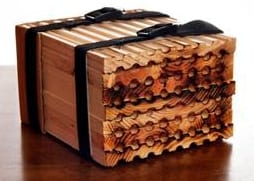by Judy Beaudette
Few strategies for keeping our environment healthy are as interesting, simple and fun as raising mason bees, tiny insects that are gaining popularity with gardeners and farmers alike. What’s more, encouraging wild mason bees to your slice of earth – no matter how small or urban – could help counter negative effects of declining honey bee colonies. Some experts even believe that continuing to build up wild bee populations, and managing them to work more extensively as orchard or field pollinators, could be an important step in ensuring that some of our most nutritious foods, like almonds, melons, and blueberries, continue to be readily available, high in quality, and affordable.
So, what is a mason bee? And how is it different than the European honey bee, known and loved by all for putting honey on our biscuits? For starters, mason bees don’t make honey. But they do pack a punch with their pollination skills, making it possible for plants to set seed and reproduce, for fruit trees and berry canes to increase their yield, and for flower landscapes to burst with color. They are extraordinary pollinators – just 250-300 females can pollinate an entire acre of apples or cherries – and are often touted as being more efficient than honey bees. Of the roughly 150 mason bee types in North America, most are native. Also, many types of mason bees occur naturally over wide geographic regions, so it’s possible you have some flitting about your backyard already. With a few supplies and some knowledge in hand, you could easily start propagating your own population of these native pollinators.
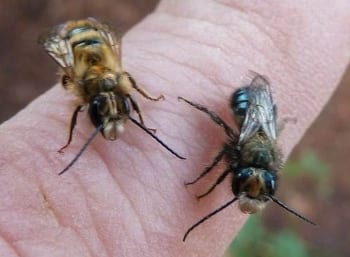
Two mason bee types – the Horn-faced bee (left) and Blue Orchard Bee – are currently used commercially for their super pollination skills. Photo courtesy of Crown Bees.
A Gentle, Tunnel-Nesting Bee
Before luring mason bees into your garden, it’s helpful to understand some basics. They are tunnel-nesting, solitary bees, which means that unlike the social honeybee, every female is a “queen” who lays eggs and raises offspring on her own, without the support of a highly-organized, social colony. They are non-aggressive and rarely sting. These bees lay their eggs inside existing tunnels, such as those left by wood-boring beetles or the hollow stems of pithy plants. Luckily, mason bees also nest in man-made tunnels – if the tunnel meets certain criteria (more on that later).
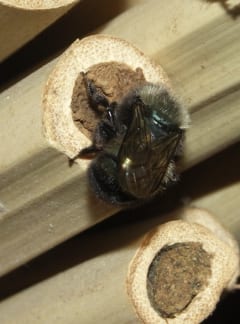
Mason bees will use hollow reeds as nests. This tunnel has been plugged with mud to protect against predators. Photo by Mace Vaughan
Early spring mason bees emerge from hibernation when temperatures reach about 55 degrees (some types of mason bees emerge in late spring or summer under different conditions, but in general they are spring pollinators). After mating and finding an existing tunnel for her nest, the female bee gathers mud in her large jaws and uses it to build a wall at the back of the tunnel – thus the name “mason bee.” Next, she makes dozens of visits to garden flora to collect pollen and nectar, which she heaps into a golden nugget at the end of the tunnel. This nutritious pollen-nectar mass will be her egg’s first meal when it hatches. Finally, she backs into the tunnel and deposits an egg on top of the food source. Once the egg is laid, the female bee collects more mud and uses it to build a wall that seals off the egg inside its own chamber. She repeats this process until the tunnel is filled with well-provisioned eggs, each tucked inside its own cell partition. Then she closes the tunnel with a mud plug to protect her offspring from predators.
An Active Spring Pollinator
This pollen-gathering and egg-laying work is done during the early spring months – when spring flowers, bushes, and fruit trees are in bloom. In the US, this typically occurs between February and May, depending on where you live. A mason bee will fill as many nesting tunnels as she can during her roughly 4-week life span – pollinating flowers profusely as she forages for food to supply her nest. Then she dies.
Inside the nesting chambers, eggs begin their transformation to adult bees. They hatch into larvae and consume the pollen-nectar masses. After a rest period, the larva spins a cocoon, and by about September, a fully-formed adult bee lies inside each chamber (if you purchase or make a special observation tray, you can actually watch this process happen). The adult bee now waits through the winter months until the spring air temperature rises to a consistent 55-degree range, at which point it emerges from the tunnel to mate and repeat the egg-laying, pollen-gathering cycle all over again.
How to Start Attracting Bees
During the early spring months, you can try attracting mason bees by providing nesting tunnels, plenty of bee food, and a mud source. Mason bee houses can be bought or made from wood, thick paper straws, or hollow reeds. My father started his mason bees years ago by making a few wooden nest blocks in one afternoon. He simply drilled a non-treated block of wood with about twenty holes that were 5/16” in diameter, the size preferred by mason bees.
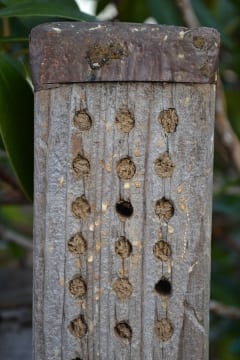
Wood nest blocks are simple to make, but can lead to pest and parasite problems if not used properly. Photo by Judy Beaudette.
By using a sharp drill bit, he ensured the holes were free of splinters (important), and he did not drill all the way through to the end (bees won’t use the holes if you do). Innocently, he drilled his holes 4 inches deep – not an ideal depth. Six-inch holes are better. Here’s why: the mason bee controls the gender of each egg she lays. Female eggs are deposited in the back of the tunnel (tucked away from rummaging woodpecker beaks or other predators) and males in the front. Since mason bees lay more male eggs than females, a 6-inch tunnel produces more female bees, which in turn increases the potential for a bigger bee population the following year.
According to Mace Vaughan, the Pollinator Program Director at the Xerces Society (a nonprofit dedicated to protecting invertebrates and their habitat) the rustic 20-hole nesting box is fine, with a critical caveat. He cautions that in order to keep your bee population safe from debilitating disease and parasite problems, you must retire the wooden nest blocks after a couple years, or use an emergence box, which allows you to clean your block without harming developing larvae. Emergence boxes – along with other DIY nest construction ideas, maintenance, and native bee facts – are explained in the must-read fact sheet Tunnel Nests for Native Bees, distributed by the Xerces Society. See Additional Resources at the end of this article for a link to this free publication.
If making mason bee nest boxes is not your thing, you can purchase a wide variety of types at gardening centers or online through companies like Crown Bees, located in Washington State. Dave Hunter, owner of Crown Bees, discourages the use of wooden nest blocks. He recommends stackable wood nesting trays, bundles of reeds, or paper tubes, which are easier for keeping bees healthy and growing their numbers.
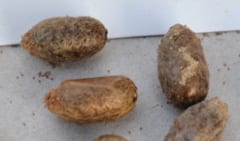
Wood nesting trays allow you to remove cocoons for visual inspection and cleaning. Courtesy Crown Bees.
Unlike the 20-hole nesting block, these three options (which you can make or buy) can be opened during the autumn months, enabling you to remove the now-sturdy cocoons. Once “harvested,” you can count the number of fully-formed bees you have. You can also inspect cocoons for parasites or disease, clean the cocoons if desired, and even share a handful with neighbors. Wooden nesting trays and paper tubes are also far easier to clean (or replace) on a yearly basis – and minimizing disease, parasites and other pests is important for maintaining or increasing bee populations each year.
Where to Place Your Nest
Regardless of the nest type you choose, be sure to place it in the proper location. Mount it securely on the side of a building, tree or fence where it will receive the warm morning sun (east or south sides are best) and protection from wind and rain. Bees need warmth to fly and dry nesting tunnels to propagate. Placing the nest four to seven feet off the ground provides additional protection from moisture, and it’s a good height for observing your bees. Try to have a clay-like mud source nearby – within about 50 feet, if possible.
It’s important to place your nest within 200-300 feet of pollen-rich, spring-blossoming plants and trees, so the bees need not waste energy or time foraging for food. Also, it’s ideal if nearby plantings offer blossoms during the bee’s entire foraging season, so females can lay eggs to their full potential.
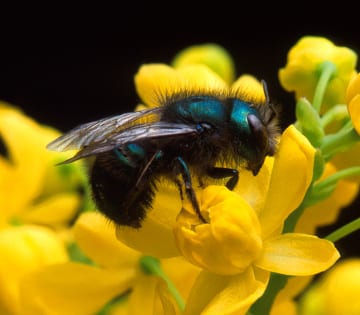
This mason bee, Osmia ribifloris (on a barberry flower), is an effective pollinator of commercial blueberries. Photo Courtesy of USDA_ARS, by Jack Dykinga.
For a list of native plants that attract these native pollinators, check out the fact sheets offered by The Xerces Society called Plants for Native Bees; each fact sheet targets one of seven specific regions in North America. And finally, try to solve your garden pest problems without using pesticides. Many types can be harmful or even lethal to bees.
Protect Your Nest during Cold Winter Months
In the fall, take down your egg-filled nest boxes and store them in a dark, unheated garage or shed during cold winter months. In early spring, prior to the onset of fruit tree blossoms and other spring-blooming flowers, return cocoons to your garden. As the days warm to a 55-degree range, watch for bees streaming in and out of your nests and then for mud-plugged holes, indicating that a new batch of pollinators – and another season with mason bees – is on the way.
Additional Resources for Raising Mason Bees
Tunnel Nests for Native Bees: Nest Construction and Management www.xerces.org/wp-content/uploads/2009/11/tunnel-nest-management-xerces-society.pdf
Dogterom, Dr. Margriet. 2009, 2nd Ed. Pollination with Mason Bees: A Gardner’s Guide to Managing Mason Bees for Fruit Production. BeeDiverse Publishing.
Plants for Native Bees, a series of fact sheets targeted for seven regions in North America. www.xerces.org/fact-sheets
www.crownbees.com offers a plethora of information about mason bees and how to manage them. If you sign up for Bee Mail, they’ll send you a monthly reminder with timely information about caring for your mason bees.
About the Author
Judy Beaudette is a freelance writer who lives near Seattle, WA. She can be reached at judy.beaudette@gmail.com.

